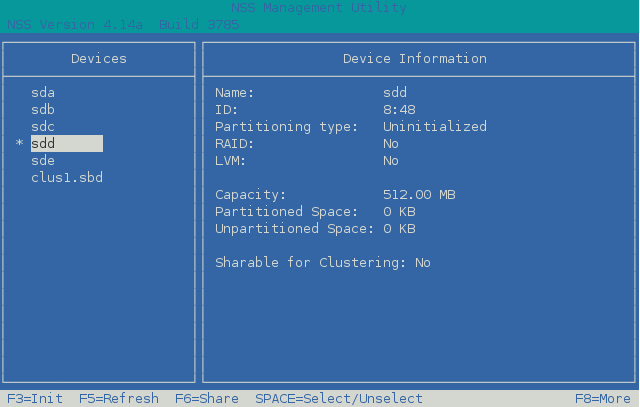6.4 Viewing Device Details
NSSMU allows you to view the following information about each device:
|
Parameter |
Description |
|---|---|
|
Name |
Specifies the Linux device node name in the /dev directory. Examples: sda, sdb, sdc, sdd, and so on |
|
ID |
Specifies the major and minor number assigned to a block device on the server. Example: 8:0, 8:16, 8:32, 8:48 |
|
Partitioning type |
Specifies if the DOS or GPT partitioning scheme is used to format the device. A device that is not partitioned is reported as Uninitialized. A device that contains a non-mirrored Novell Cluster Services split-brain detector (SBD) partition is typically formatted as MS-DOS. A device that contains a mirrored SBD partition has a partition type of NA (not applicable) because it is a RAID 1 device. Values:
|
|
RAID |
Specifies whether the device is an NSS software RAID device. Values: Yes or No |
|
LVM |
Specifies whether the device contains an LVM volume group. Values: Yes or No |
|
Capacity |
Specifies the total amount of space available on the device. |
|
Partitioned space |
Specifies the amount of space in use on the device. |
|
Unpartitioned space |
Specifies the amount of free unpartitioned space available on the device. For MSDOS devices, free space includes unallocated space in an extended DOS partition. |
|
Shareable for clustering |
The device can be used for shared Novell partitions. Use with Novell Cluster Services SBD partitions and cluster-enabled NSS pools. The status is stored on a 4 KB partition on the device. Values: Yes or No (default) |
To view device details:
-
From the NSSMU menu, select Devices, then press Enter.
-
Select the device that you want to view by using the Up-arrow and Down-arrow keys.
-
View details about a selected device under Device Information.

-
Press Esc twice to exit NSSMU.